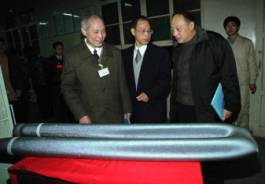|
|
|
Major
Achievements
During the past 50 years, China
has made remarkable achievements in the fields of science and technology,
as follows:
The discovery of the Daqing
Oilfield
In 1953, the leading geologist Li Siguang, based on his geomechanics
theory and thorough geological investigation, pointed out that China
had abundant oil and gas resources. In the morning of September
26, 1959, oil was extracted near Daqing City, Heilongjiang Province.
Through the painstaking efforts of oil workers, it took only three
years to construct the Daqing Oilfield, which soon reached the advanced
world level, with an annual output of more than 50 million tons
of crude oil. The Daqing Oilfield provided valuable experiences
for the further development of the Chinese petroleum industry.
The building of the first atomic
reactor
On June 30, 1958, China built her first heavy-water reactor and
circular accelerator. This atomic reactor had a thermal power of
7,000-10,000 kw, and its circular accelerator could accelerate alpha
particles, making its energy output reach 25,000,000 EV. In December
1980, China built a high-flux atomic reactor, indicating that Chinese
nuclear technology had reached the advanced world level.
|

China's
first experimental production line of polycrystalline silicon with
an annual output of 100 tons and with its own intellectual property
rights has been passed appraisal. This shows that China's polycrystalline
silicon production has been up to the world level.
 On
Nov. 20, 1999, China's first manned space ship "Shenzhou"
was successfully launched.
On
Nov. 20, 1999, China's first manned space ship "Shenzhou"
was successfully launched.
|
|
The successful testing of atom
and hydrogen bombs
On October 16, 1964, China successfully detonated an atomic bomb
in Lop Nor in the Xinjiang Uygur Autonomous Region, thus becoming
the third country to possess the atom bomb, following the United
States and the former Soviet Union. In June 1967, China successfully
detonated its first hydrogen bomb.
The synthesis of crystalline
insulin
After six years of arduous work, in cooperation with other research
units, the Biochemistry Institute under the Chinese Academy of Sciences,
on September 17, 1965, synthesized crystalline bovine insulin, a
bioactive protein. China thus became a world leader in this research
field.
The positron and negatron electronic
collider
In October 1988, the Beijing Positron-Negatron Electronic Collider
was successfully installed, not only to develop scientific research
in particle physics, energy, materials, biology, chemistry and integrated
circuits, but also to produce products for export.
Nuclear power stations
In 1970, China began to design its first nuclear power station,
the Qinshan Nuclear Power Station, in Haiyan County, Zhejiang Province.
The first-stage project of this power station, with an installed
capacity of 300,000 kw, began to be constructed at the beginning
of 1985. Meanwhile, construction began on the Dayawan Nuclear Power
Station, 60 km east of Shenzhen, Guangdong Province, with an installed
capacity of 1,800,000 kw.
Carrier rockets
In May 1980, China successfully launched a carrier rocket to
a predetermined area in the Pacific Ocean, which was the first time
for China to launch a rocket to land in international waters from
its territory. In 1982, a China-made rocket passed its first space
flight test, thus making China the fourth country to possess new-type
space microthrust rocket engines, following the United States, the
former Soviet Union and Japan. In October 1982, China successfully
launched a carrier rocket from a submerged submarine, and in September
1988, from a nuclear submarine. Chinese carrier rockets include
the Long March carrier rockets and the “Storm I” carrier rocket.
Satellite launching
technology
On April 24, 1970, the China-made “Long March I” carrier rocket
successfully took the “Dongfanghong I,” China’s first man-made satellite,
into orbit. This made China the fifth country in the world able to
independently develop and launch man-made satellites, following the
former Soviet Union, the United States, France and Japan. Later, China
successfully developed and launched scientific experimental satellites,
retrievable satellites and stationary communication satellites, mastering
the advanced techniques of satellite retrieval and multiple satellite
launching with a single carrier rocket and synchro-positioning technology.
On April 7, 1990, at the Xichang Satellite Launching Center, the “Long
March III” carrier rocket successfully launched “Asia I,” the first
foreign satellite launched by China, marking the entry of China-made
satellites into the international market. |
|



